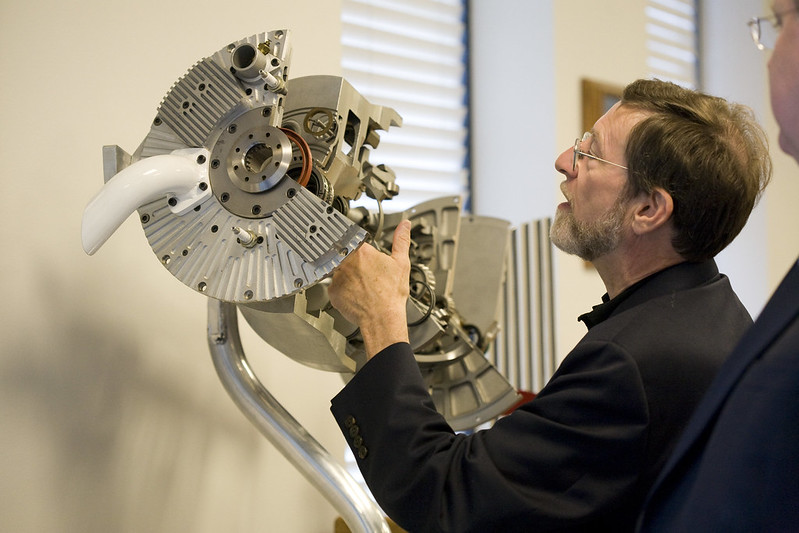No, 3D Printing Alone Cannot Make an Organization Innovative
Can additive manufacturing (AM) simply make an organization innovative by throwing a few 3D printers at it? Is it able to transform a company through mere exposure to the technology alone? The obvious answer here is: of course not.
Many companies have bought 3D printers in a flawed desire to become more innovative. It’s as if they’re hoping that the simple addition of a system to an office will serve as a kind of shrine to innovation. Once installed, the 3D printer’s magical innovation aura will waft over the team and make them innovative.
A Box is a Box
Perhaps it’s the universal applicability of the television that confuses people. You can put someone in front of a TV and they’ll drift into a flickering, colorful stupor as multicolored rays light up their face and life. Uninitiated, we can go from active to passive just by introducing a TV to a room. Maybe this has led some to think that a 3D printer will be as usable. And, perhaps, we in the AM industry are to blame here in part. After all, we sold these things as easy to use.
A box is just a box. However, a 3D printer can become a tool if it’s in the right hands. A 3D printer won’t magically make a person innovate. It won’t even make them more likely to do so. For that to happen, they have to know how to use it.
3D Printer Training
Without taking the 2,000 hours or so to learn CAD, a user can’t make the specific solutions necessary to really get the most out of the printer. What’s more, they would need additional training to understand 3D printing technology itself, at least at a high enough level to produce designs that matter. Then, they’d have to learn to deal with the actual machine: maintaining it, calibrating it properly, etc. However, even once all of this is done, they won’t magically become innovative.
Culture over Boxes
To make a company more innovative, team members might consider organizational design and culture. This might include: empowering employees, allowing everyone to speak at meetings, listening to them all, cross-functional teams, and a generally more open culture. and much more.
If an employee feels as though they have to make what their boss wants or that no one will listen to them, they’re not going to be the one to make a breakthrough solution. If workers operate under “management by fear,” then innovation, learning and expression aren’t being fostered. Neither are diversity of thought or opinion. If everyone is trying to impress the boss during a brainstorm, rather than solve a problem, then the group might as well not be brainstorming at all.
Those institutional behaviors that would turbo charge a 3D printing implementation are those that would drive innovation internally anyhow. If a company is currently not innovative, it will need to find its own path to innovation through the difficult, but potentially cathartic process of organizational change towards a more open culture where all voices are heard.

From the “Collecting Innovation Today” interview with innovator Carroll Shelby on August 19, 2008 at Carroll Shelby Licensing, part of The Henry Ford’s “OnInnovation” project that celebrates the contributions of today’s innovators. Photo from the collections of The Henry Ford, Dearborn, Michigan, USA. Photographer, Michelle Andonian.
There’s a “Me” in Team
Even if an organization does evolve to exhibit an open culture, it doesn’t mean that a given manager will be capable of fostering innovation correctly. If a manager is too fond of listening to themselves think and speak, they may drown out the voices around them. If they micromanage, they’ll transform the 10 voices surrounding them into their own and stifle any truly independent thought. So even with the right culture and tools, a team could still have the innovation wrung out of them with the wrong manager. Teams of rivals may super charge a company’s sales department, but collaboration and using the unique skills present in all members will probably get a business further in innovation scenarios.
The “I” in Fail
Even then if all of the other preconditions are met, a given manager may be the wrong person for the job. An organization needs a problem solver who understands the company’s culture and is knowledgeable about the business challenges.
An unconventional thinker will do well, but they will do even better if paired with a conventional thinker. If a manager is motivated to show off cool ideas, then they may hardly ever develop solutions. If they’re paid to solve problems, then they may gravitate to the problems that leaders have, not necessarily those that the entire team has. If their career depends on this, they may be too cautious. If they have a sandbox, they’ll just play and probably won’t build.
A lot of success in innovation derives from alignment and motivation on a very personal level. The right teams, and the right manager, and the right incentives will have much more impact on success in innovation within an organization than any magical box will. You may give me a wand but I’ll not be a wizard just yet.
The InCompetence Center

From the “Collecting Innovation Today” interview with innovator Steve Wozniak on August 18, 2008 at the Computer History Museum, part of The Henry Ford’s “Oninnovation” project that celebrates the contributions of today’s innovators.
Companies will often have an innovation department. This always puzzles me because it indicates that only the people in this department can innovate. Or, worse still, it could indicate that no one else is allowed to innovate. Just like HR is the only team dedicated to employee policies, this small table is only for the employees who are innovating.
Competence centers are meant to spread knowledge and ability, but are often fortresses behind which innovation is curtailed. The focus on only boasting senior members, engineers, or other employees with very specific roles bothers the hell out of me. It’s the people on the shop floor that can contribute the most meaningful innovations, problems, and insights. The person in the factory, delivering the product to small shops, or ensuring the product looks good in a tiny kiosk somewhere is the right employee to inform a manager about the biggest unseen issues. Extrapolating correctly on their findings will often also have the biggest impact.
A lot of people turn to cosmetology in innovation whereby a new green tea flavor, website, video, or silly gimmick will take attention away from truly innovative packaging or new products that could result in completely fundamental innovation. Also, by restricting innovation to the “innovation people” alone, a business doesn’t obtain the insights from across the organization.
Armed with an ¨innovation mindset,” they also take a clinical buzz word driven approach to innovation and forget that as parents, children, partners, friends, and neighbors, employees can introduce widely shared problems to the team solving. The ivory-tower-innovation-industrial-complex is a self-perpetuating, self-mythologizing series of expensive brainstorms and exercises that delude businesses into a false sense of security.
Exceptions
Therefore, culture, incentives, and capturing the broadest possible opinions are much more important than any box. Now, there is an exception that we’ve seen happen across the 3D printing industry. In some top-down businesses that are very process-driven and regulated, 3D printers can introduce innovation by empowering shop floor employees to design problem-solving parts by themselves.
In these bottom-up innovation paths, we can see that the right employee can arm themselves with a printer (if they have CAD skill) and then bring to management a part they’ve already 3D printed to solve a problem. Here, we can see that this employee has a printed, concrete example that can show off the solution immediately. This has worked many times across many companies in 3D printing.
General availability of free CAD and 3D printing classes that anyone can follow would be very valuable to any company. General availability of spare, unconstrained 3D printing capacity will also foster teams to maker their own solutions.
As a tool for innovation, a 3D printer will not work. However, if we make the courses and the capacity available company wide to all employees, then eventually some innovation should follow from it. Not in a guided, predictable or department-driven manner. Not via any one manager, but through the eventuality of one employee becoming so annoyed or inspired by something that they solve it themselves.
If you just put a few 3D printers somewhere and expect them to spit out innovation by themselves—even in the hands of a small elite team—it will not work. I could wear a tutu but it wouldn’t mean that I can dance. Nor, if I wore it long enough, would I become a ballerina.
Feature image courtesy of Ultimaker.
Subscribe to Our Email Newsletter
Stay up-to-date on all the latest news from the 3D printing industry and receive information and offers from third party vendors.
You May Also Like
Precision at the Microscale: UK Researchers Advance Medical Devices with BMF’s 3D Printing Tech
University of Nottingham researchers are using Boston Micro Fabrication‘s (BMF) 3D printing technology to develop medical devices that improve compatibility with human tissue. Funded by a UK grant, this project...
3D Printing Webinar and Event Roundup: April 21, 2024
It’s another busy week of webinars and events, starting with Hannover Messe in Germany and continuing with Metalcasting Congress, Chinaplas, TechBlick’s Innovation Festival, and more. Stratasys continues its advanced training...
3D Printing Webinar and Event Roundup: March 17, 2024
It’s another busy week of webinars and events, including SALMED 2024 and AM Forum in Berlin. Stratasys continues its in-person training and is offering two webinars, ASTM is holding a...
3D Printed Micro Antenna is 15% Smaller and 6X Lighter
Horizon Microtechnologies has achieved success in creating a high-frequency D-Band horn antenna through micro 3D printing. However, this achievement did not rely solely on 3D printing; it involved a combination...





























